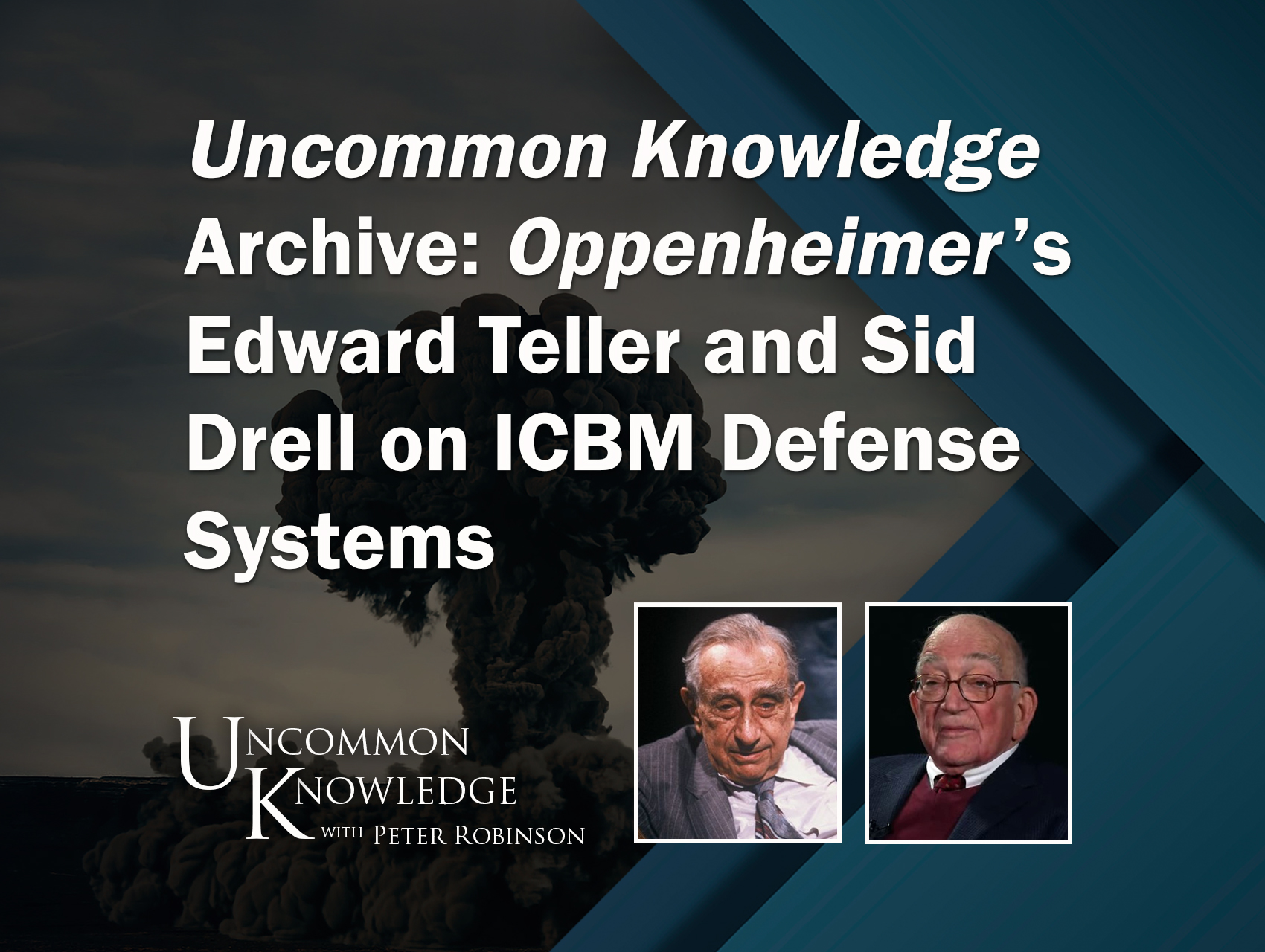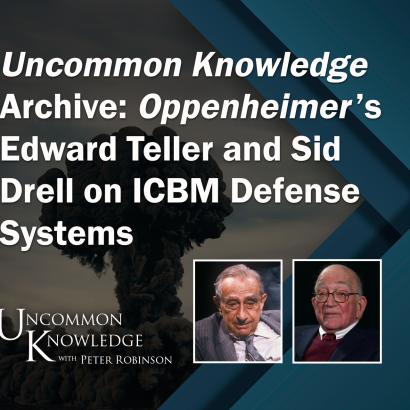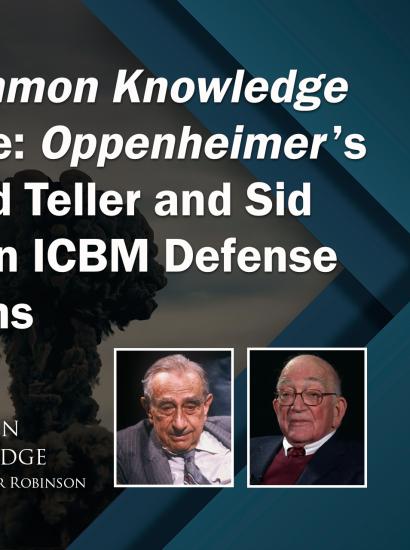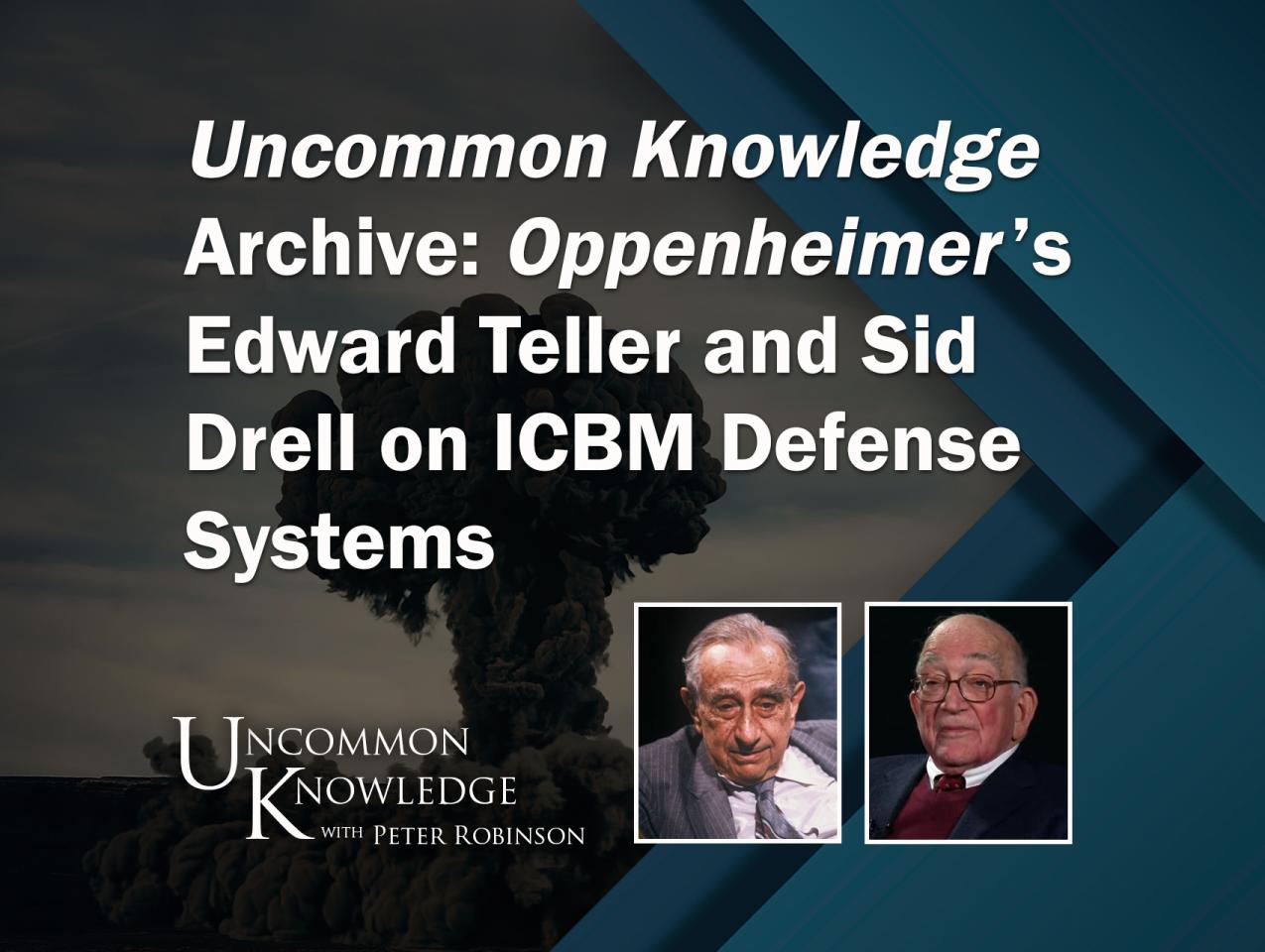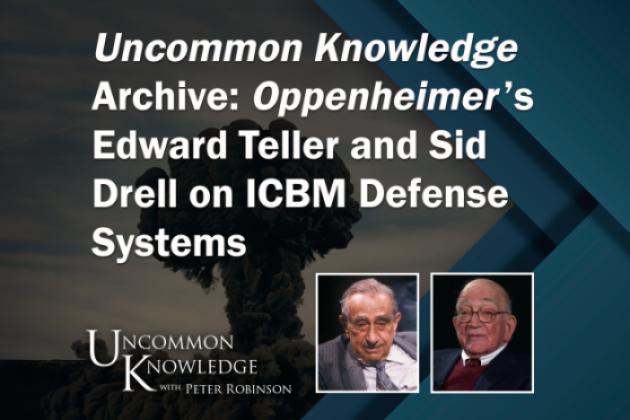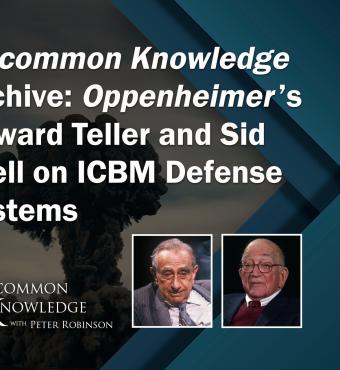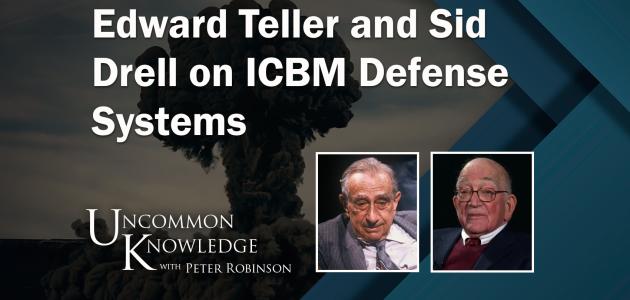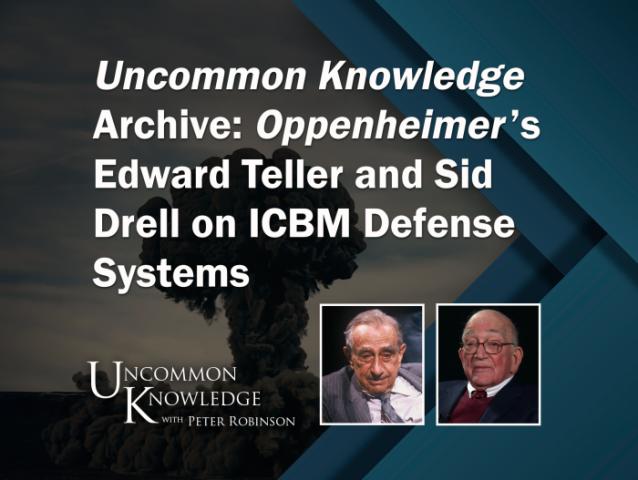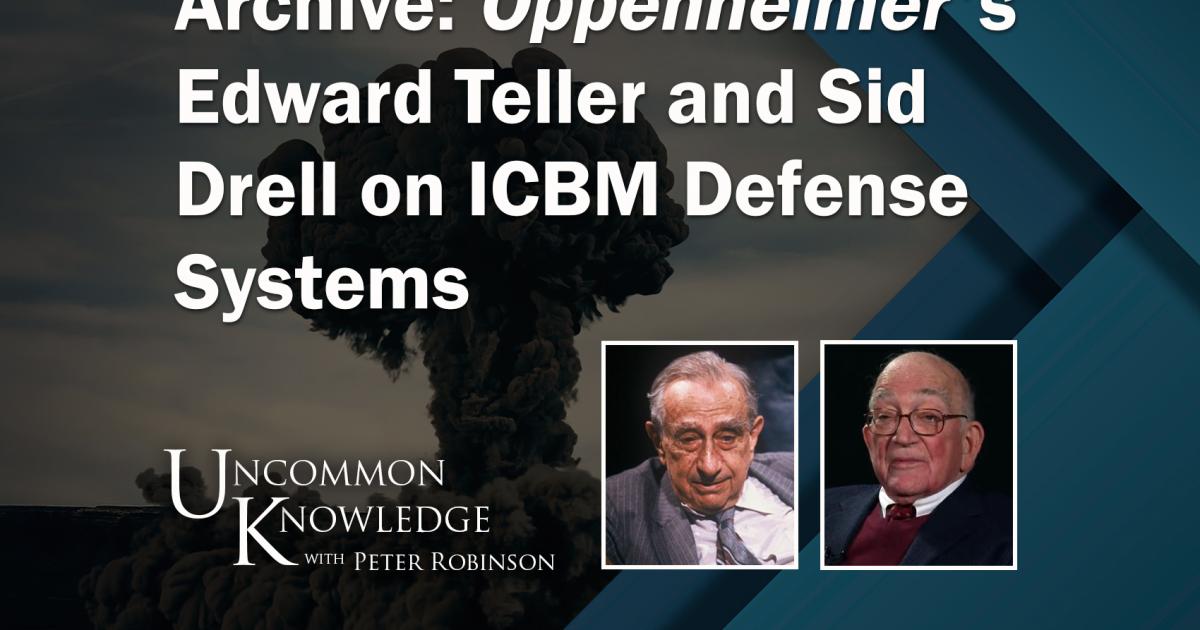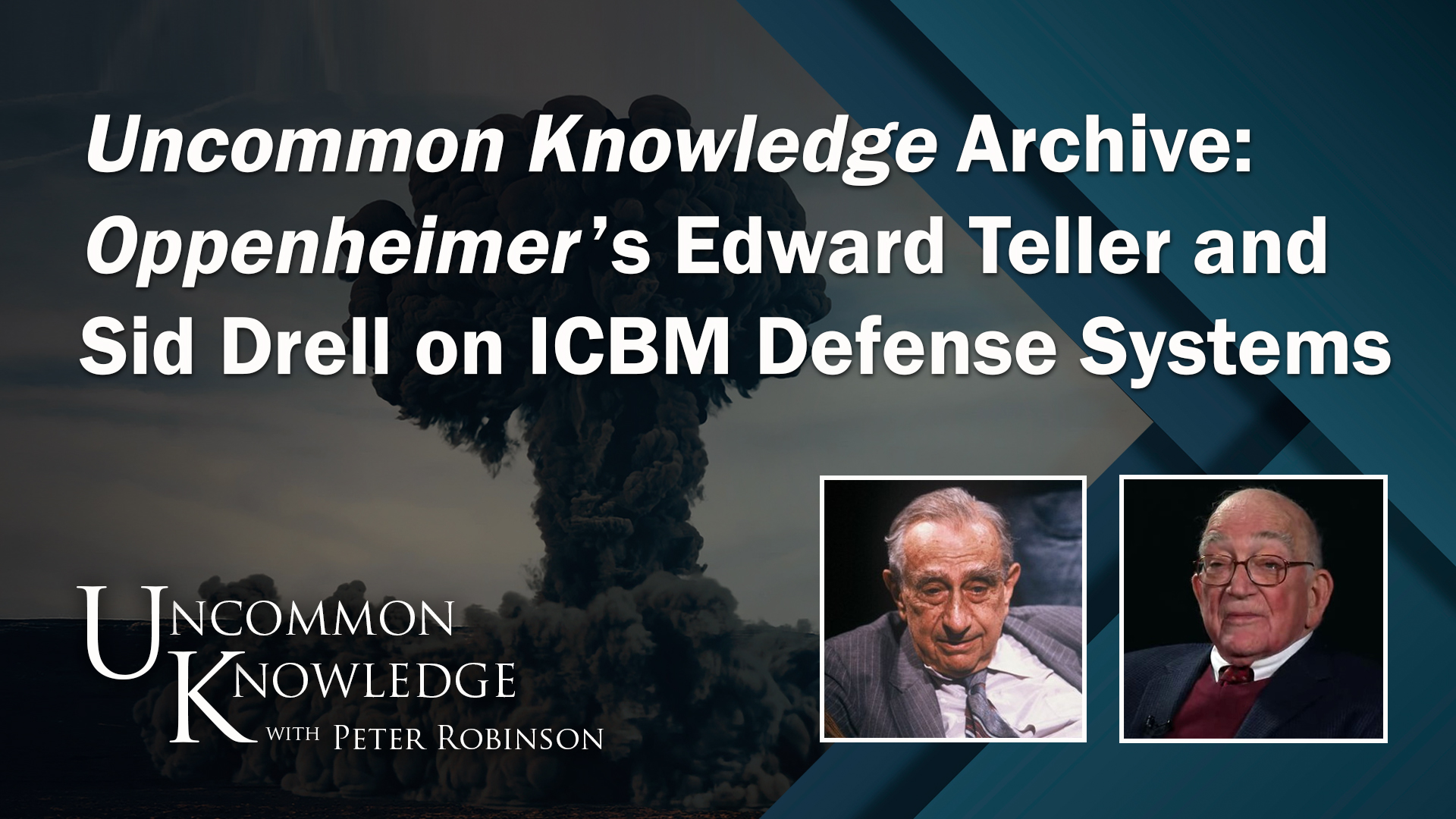With the recent announcement that Oppenheimer, the film directed by Christopher Nolan, had garnered 11 Academy Award nominations, it seemed timely to pull from the archives this rarely seen episode of Uncommon Knowledge with Peter Robinson from 1996 (the third episode ever shot), featuring nuclear physicists and Hoover senior fellows Edward Teller and Sidney Drell. Teller was involved in the development of the first atomic bomb and is prominently featured in Oppenheimer. Drell was an expert in the field of nuclear arms control and cofounder of the Center for International Security and Arms Control, now the Center for International Security and Cooperation. He later was deputy director of the Stanford Linear Accelerator Laboratory (SLAC) from 1969 until his retirement from the lab in 1998. In this episode, Teller and Drell engage in a lively debate about the role of nuclear weapons and how they should be regulated in the late 20th century.
To view the full transcript of this episode, read below:
Peter Robinson: Welcome to "Uncommon Knowledge." I'm Peter Robinson. Today, a show from our archives. Like millions of Americans, I just saw the movie "Oppenheimer," which has now been nominated for 13 Academy Awards, including Best Picture, Best Actor, and Best Director. One of the characters portrayed in "Oppenheimer" is the physicist, Edward Teller, whom I knew when I first came to the Hoover Institution some years ago now. You're about to see a conversation between physicist Edward Teller and physicist Sidney Drell, in which they discuss the Strategic Defense Initiative. Edward Teller is in favor, and Sidney Drell was opposed. The year is 1996. Candidate for President, Republican candidate Bob Dole, wanted to proceed with a Strategic Defense Initiative, also known, as you may recall, as "Star Wars," and President Bill Clinton opposed it. From our archives, Edward Teller and Sidney Drell in 1996. Welcome to "Uncommon Knowledge." I'm Peter Robinson, a fellow at the Hoover Institution. Our show today, "Star Wars." Here's the issue. Bob Dole and the Republicans in Congress want to begin deployment of a national missile defense system and to do so quickly. President Clinton and other Democrats say, "Let's wait a few years." The system would be designed to defend against a particular kind of missile, ballistic missiles, use your imagination. These are missiles that are capable of traveling from one continent to another, say from Asia to North America. Now, why would we need a missile defense system? Here's the situation today. A missile is fired, our satellites in space tell us immediately, but to protect our population, there's nothing we could do. We could, of course, fire missiles back at the aggressor, a bigger missile, in this case, because it's American after all. But as I say, there's nothing we can do to protect our own population, and firing a missile in retaliation would only produce a lot of dead people in both places. Now, imagine a missile defense system. It could be land-based, sea-based, or based in space, but whatever the system, the aim would be the same. The missile is fired, but it's destroyed before it can harm anyone. Would such a system work? If it did work, would it be worth the cost? Our guests disagree. Dr. Sidney Drell is Deputy Director of Stanford University's Linear Accelerator and an advisor on nuclear weapons to one president after another. Dr. Edward Teller worked on the Manhattan Project during World War II and later developed the hydrogen bomb. He is a fellow at the Hoover Institution. Just as Dr. Drell and Dr. Teller disagreed today, they disagreed vehemently when Ronald Reagan first proposed a Star Wars system back in 1983. This is an issue with a history, at least 13 years of history. In March, 1983, President Reagan first called for research into a Strategic Defense Initiative, or "Star Wars." Dr. Teller, you were in favor of President Reagan's initiative. Indeed, you were one of his close advisors in the matter. And Dr. Drell, you opposed it. Can you first explain what is or what was envisioned as a Strategic Defense Initiative? What was it supposed to do? What was it supposed to protect against? And then I'd like to know why you opposed it.
Sidney Drell: The original proposal of President Reagan for the Strategic Defense Initiative was to build a defense to defend the United States, the entire country, against the possibility of a massive missile attack from the Soviet Union, attacked by thousands of ballistic missiles and their warheads. I opposed it then strictly as a scientist. The goal of defending ourselves, of defending our vital interests is a valid goal. Every president thinks of it, every human being thinks of it in terms of our families. It's a basic instinct. I opposed what was proposed originally by President Reagan as a scientist because I felt that the technology did not exist to meet that goal. I favored then, I still do, research to try and develop to advance what technology can do, as well as to understand the limits of technology. Even today against a massive attack. Now, that's not what we're talking about today. I'm answering that question.
Peter Robinson: All right. Dr. Teller, you were in favor of Ronald Reagan's proposal. Why?
Edward Teller: I was very happy at the time that he emphasized defense. I was uncomfortable about the question whether it can be done, particularly whether it can be done without the use of nuclear explosives. However, under the impact of his statement, a number of us, particularly my friend Lowell Wood in Livermore, looked in great detail into the question how the defense can be done. And I don't have any other means but to put it very briefly here. The result was that the development of increasing accuracy give strong hopes for a defense which indeed was non-nuclear, which was based on the idea, here is an incoming object. We have looked at it from the very beginning, from space, and as soon as possible, we want it to collide with very much smaller objects, and the collision should destroy the attacking object. This looked to me at the time as something difficult but possible. And let me put it this way. In the last 10 years, or at least in the last six or eight, it seemed to me more and more hopeful. if we are working on it hard.
Sidney Drell: I would like to respond to some of these things where we agree and disagree.
Peter Robinson: Please.
Sidney Drell: The words of President Reagan were translated by his administration into a very expensive program which cost something like $40 billion.
Peter Robinson: Over a period of time or?
Sidney Drell: Over a period of time starting in 1983. It was a program that was directed to field a system by a certain date. It was not an R&D program to see what one can do. It was directed to field a system at a certain date. That led to a lot of waste, and I think it was technically not at the standard that one expects from scientists entering into the public arena. We have an obligation to be as conservative and as rigorous in our thinking and in our predictions, technical predictions as we are in the laboratory. Many claims were made and that's why many of us, including myself, got involved in saying that's not realistic. Let's do research. I supported the research. I did not support the implementation.
Peter Robinson: Go ahead. Yes?
Edward Teller: To begin with, an enormous waste of money, $40 billion, to be expended over a number of years, like 10, that is considerably less than 2% of our defense budget.
Peter Robinson: You don't dispute that?
Sidney Drell: That's a correct statement.
Peter Robinson: All right.
Sidney Drell: That's absolutely a correct statement.
Edward Teller: Now, to my mind, the main job of our project is to defend the American people. That 2% of our military expenditure on that is too much, is a point I want to state without making the obvious statement what I think about it.
Sidney Drell: The function of the United States government is to protect the United States and our interests. That's more than saying the Defense Department to defend us. During that time with Russia, we were engaged in many efforts, diplomatic and strategic as well as military, to try and reduce the nuclear threat.
Peter Robinson: During the Reagan years, you mean.
Sidney Drell: During the Reagan years, during the Carter years.
Peter Robinson: The Cold War.
Sidney Drell: Until the Cold War was over. And so I think it's important to put the effort, that $40 billion effort, and that is a lot of money, by the way, into the context of how it would impact our strategic and diplomatic efforts, which did succeed thanks to great initiatives by President Reagan and Secretary Schultz, for which I'm very appreciative, in reducing the nuclear threat considerably by reducing by the Strategic Arms Reduction treaties. And the problem of managing how we go about exploring or even deploying defense while doing that is a very complex political problem. We may have different ideas there. We're not experts. Let me talk about now.
Peter Robinson: Politics, scientific wrangling. So far we've been talking about what takes place inside this country, but the bad guys are on the outside. The Clinton administration says, three years of research and then we'll think about whether we need to deploy, and the Republicans say, no. Three years and we will deploy. Now, so far as I am following the political debate, a huge element in this decision is how one assesses the threat. Now, the Clinton administration, Secretary of Defense Perry, has been taking a lead on assessing the threat. The Clinton administration says, at present, only Russia and China have nuclear-armed ballistic missiles that can reach the United States. It will be at least a decade, in the Clinton administration's view, before other nations develop such missiles. Although it could be somewhat less than a decade before North Korea develops missiles that could strike Hawaii and Alaska.
Sidney Drell: The extreme tip of Hawaii and the extreme tip of Alaska, the Aleutians. Not the--
Peter Robinson: Correct. So this is not right.
Edward Teller: May I interrupt for a moment? I want to remind you.
Peter Robinson: Yes?
Edward Teller: That fission was discovered in December '38. Five and a half years later, there was an explosion on Hiroshima. To make 10 years of decisions in advance is nonsense.
Peter Robinson: Former CIA director James Woolsey, a Clinton appointee, says the administration itself is wrong about the threat and that, whereas the threat to the contiguous, the continental or contiguous 48 states may not be serious from nations other than Russia and China for another decade or so, there is the matter of threats to our, I'm quoting now from Woolsey, "Threats to our friends, "our allies, our overseas bases and military forces, and indeed, to some of the 50 states." Woolsey adds, in congressional testimony, and this is a man whom Clinton chose to run the CIA, "It is quite reasonable to believe that within a few years, "Saddam Hussein and the Chinese rulers will be able "to threaten something far more troubling than firings of relatively inaccurate ballistic missiles." So this is the question, how grave is the threat?
Sidney Drell: Now, I think Edward and I will agree on this one. What Woolsey may be talking about there is, when he talks about those countries, are ballistic missiles in the theater area, less than a thousand kilometers, one to 2,000 kilometers. We are testing those systems now. That is not the issue of the Defend America Act. The Defend America Act is intercontinental range ones. I don't think we have any difference that the importance of, first of all, to field a system against non-nuclear warheads makes a lot of sense. We saw that in the Gulf War. The issue is defending the continental United States and the inhabited areas of Alaska and Hawaii against nuclear warheads coming on multi-thousand-kilometer-range missiles. It's a more difficult problem. That's the issue of doing the research now and not committing to deployment.
Peter Robinson: And in your judgment, you're willing to rest content that for the next decade we have only Russia and China effectively to worry about.
Sidney Drell: I'm willing to rest content, and I'd like to say, I am confident that the best policy for us, given where the threat stands now, the engineering difficulties for a country like North Korea to get the propulsion systems, the guidance systems, to do the test firings of a new missile, that that timescale is such that doing the best R&D, research and development now, so that we can assess again every year as we go along expecting that this program will keep us ahead of the threat, I think that that's a very prudent policy.
Peter Robinson: Dr. Teller?
Edward Teller: I am not only worried about ballistic missiles carrying nuclear warheads. I am worried about ballistic missiles carrying anything, explosives.
Peter Robinson: Chemical weapons.
Edward Teller: Chemical weapons. Biological weapons. In the Middle East, these weapons have been used in a terrifying and effective way.
Peter Robinson: During the Iran-Iraq War.
Edward Teller: Between the Iran-Iraq War.
Sidney Drell: Very brutal.
Edward Teller: And to this, all people are exposed, whether or not nuclear explosives are developed or not. And the question is not as simple as to make experiments and then decide yes or no. The very act of deployment will uncover difficulties, complications. We ought to begin deployment as soon as possible. Maybe now. For whatever we can do now, for the limited means that are best to do now, and not say in a nice way that the American public will be happy to hear, "Don't worry." Nothing is going to happen for 10 years." That may be excellent election policy.
Sidney Drell: I'm sorry, Edward. That's a caricature of what I said. That's not what I said.
Edward Teller: Excuse me. That is the way how I think things can be understood, and I'm very, very happy to see, to hear that that is not what you have said.
Sidney Drell: That's certainly not what I've said.
Peter Robinson: The present rate of spending-- Missiles being fired at us by a nutcase like Saddam Hussein sounds scary enough. But are there worse threats? What about the argument that all of this emphasis on strategic defense is a misplacement, a misallocation of emphasis and resources? New York Times quotes a Pentagon official, unnamed, but they quote him as saying the following. "A terrorist with little technical know-how "and 20 pounds of smuggled plutonium could make a bomb "powerful enough to destroy a city. That's what we should be worried about." What do you say to that?
Edward Teller: And we also should be worried about the common cold. Look, there is this problem and there is that problem, and they have absolutely nothing to do with each other. I'm wrong. They have a little something to do with each other. And I tell you what. Missile defense, independent of any terrorist, is an important thing. I agree that we should do the best. I don't agree that we shall ever really know what is the best. And in deploying we all have to take chances, and I say the chance is now. What does it have to do with the terrorist? Only this. If you go ahead with defense, and now comes the new point that I have not yet mentioned, and I'm very anxious to mention it. If you go ahead with defense, not for the United States, but as far as possible, together with our allies, with our friends, for the whole world. If at the same time we minimize our excessive secrecy today, we can bring about a better atmosphere in which measures against terrorists also will become easier. These problems are not independent of each other, two, but the kind of dependence, "Don't do this before you have done that," is nonsense.
Peter Robinson: And you agree?
Edward Teller: If we know how we can do something against terrorists, do it. If we know how to get something against missiles, do it. The two should not be compared and balanced with each other.
Sidney Drell: I agree with that but I would like to add one more dimension to this discussion, and that is, what we wanna do is reduce the danger, not only of nuclear weapons, we wanna reduce the danger of weapons of indiscriminate destruction, biological weapons, chemical weapons, nuclear weapons. The terrorist who wants to just commit terror, if he can do a little more than run a brewery in his backyard, can threaten us with biological weapons in this world. It's a terrible challenge. The fact that that's a terrible challenge doesn't mean we should ignore the ballistic missile challenge or the cruise missile challenge. Quite frankly, if I wanted to make a threat to the United States, I would think very hard about the simple cruise missiles carrying warheads hundreds of miles, not the--
Peter Robinson: Something low and fast?
Sidney Drell: Yes, yes.
Edward Teller: What we are working on, what we are emphasizing is the defense of our military forces. What we are not emphasizing is the defense of the population. And it is not only the population of our European allies who are within that range of dangerous missiles. Very important question. It is also our own population, which is not within 500 kilometers of any adversary parts, but within 500 kilometers of ships that can get as close and closer. These questions have to be looked into now and with emphasis. And I am afraid that the discussion has obscured the danger to the American people that exists now, not in 10 years.
Peter Robinson: Suppose Republicans got their way and a space defense were deployed. Wouldn't there be quite a nasty little scene on the floor of the United Nations? Secretary of Defense William Perry says that the Defend America Act would cripple the 1972 Anti-Ballistic Missile Treaty, the ABM treaty, with Russia, and have other difficult diplomatic ramifications. Do you care about that?
Edward Teller: I think the diplomatic arrangements that have been made with the government, the Soviet Union that no longer exists, has very little to do with the real issues. The real issue is now how to get together everybody in a joint way to do what is necessary or whatever can be done to reduce every danger and specifically to reduce the danger of missiles. And I put a great emphasis on missiles because it has been estimated, and I have no reason to doubt it, that the missiles are available now to 20 or 25 governments. And I don't want to put the emphasis on nuclear explosives, but on whatever the missiles can carry.
Peter Robinson: Excuse me, now that's a stunning statement. 20 to 25 countries have the ability to purchase or find, obtain, to use a ballistic missile, and they could put anything on the top of it from a nuclear warhead to my grandmother to chemical weapons? So the threat is in fact very great.
Sidney Drell: We have to be clear on numbers.
Peter Robinson: All right.
Sidney Drell: The 20 to 25 countries that Edward's talking about apply to the first generation of existing missiles whose ranges are generally less than five to 600 kilometers, not the 10 to 20.
Peter Robinson: These are short hops.
Sidney Drell: These are the theater ones. These we are working against. That is the threat that exists. The next threat that exists is gonna be the one that North Korea seems to be working on, the or something like that, which may go 3,500 kilometers, still won't reach us. And that's what I mean. There's a timescale and a threat that we have to match our program to.
Edward Teller: We talk about international agreements. I would like to have an international agreement to this effect. Anybody can fire missiles, the more the better. Happy about it. But a condition. If anyone, American or Russian or any other nation, Switzerland, wants to fire a missile, it has to be announced, let us say, one week ahead, together with purpose and orbit. And we have an international understanding and we try to plan on ways to execute it, that whoever fires a missile without announcing it, or announces it wrongly, that missile, without any further question, whether it's a missile or a cruise, can be shut down.
Sidney Drell: Let me start by saying we have an area of great agreement. I thought that one of the great moments in the history of discussion of these threats occurred at the Reykjavik Summit when President Reagan proposed getting rid of all long-range ballistic missiles. And George Schultz followed it up with a detailed discussion of that in the speech at the University of Chicago. And that to my mind is the best way to handle the ballistic missile threat. It's a verifiable scheme because big missiles cannot be hidden like little ones can. Secondly--
Peter Robinson: Dr. Drell says this. Dr. Teller says that. They agree here, they disagree there. I want to clear this up. Where exactly does each man stand? I'm going to ask you a series of questions, and I'm going to ask you to answer them in ways that eminent physicists don't like to do. That is to say with a yes or a no, but I want to understand your position.
Sidney Drell: Your question has to be a clear question. We don't answer that way 'cause we're careful.
Peter Robinson: All right, I'll do my best. Is the United States doing enough now to protect the United States and its allies from the threat of intercontinental ballistic missiles from Russia and China? Dr. Drell, are we doing enough now?
Sidney Drell: If you want a one-word answer?
Peter Robinson: Yes, please.
Sidney Drell: Yes.
Peter Robinson: Are we doing enough now to protect against the threat of intercontinental ballistic missiles from Korea? The future threat? Yes or no?
Sidney Drell: Yes.
Edward Teller: No.
Peter Robinson: No.
Peter Robinson: Are we doing enough now to protect ourselves and our allies against the threat of theater nuclear missiles? That is to say these short-hop missiles of a range--
Sidney Drell: Nuclear or non-nuclear?
Peter Robinson: Nuclear or non-nuclear.
Sidney Drell: Theater missiles? Yes.
Edward Teller: Probably yes.
Peter Robinson: Probably yes. Dr. Teller provided me with a new nightmare that hadn't entered into my consciousness. The notion of a ship pulling up from one of 20 to 25 countries and lobbing a missile at the United States. Are we doing enough now to protect against that threat?
Sidney Drell: Here I think I'll say probably yes, because when you're in that region, you're talking not only about ballistic missiles, but all sorts of ways of delivering only hundreds of miles, and to be true to my own standards, let me say I haven't looked at the whole spectrum of programs there.
Peter Robinson: Would be your impression, probably yes?
Sidney Drell: I don't know of any reason to say no, but I don't have the information to say an absolute yes.
Peter Robinson: Do you feel we're doing enough or not enough, now?
Edward Teller: Being cautious, like you are, I say no.
Sidney Drell: Okay.
Peter Robinson: Two more questions. Are we doing enough now to protect the United States and our allies against the threat of cruise missiles?
Edward Teller: No.
Sidney Drell: No.
Peter Robinson: And finally, are we doing enough now to protect the United States and our allies against the threat of a terrorist with a plutonium suitcase?
Sidney Drell: Or a biological weapon?
Peter Robinson: Or a biological weapon.
Sidney Drell: No. Absolutely no.
Edward Teller: No. And I don't know what is enough.
Sidney Drell: That's also a fair statement. That's an exceedingly difficult problem.
Peter Robinson: Dr. Edward Teller, Dr. Sidney Drell, thank you very much.
Edward Teller: Thank you.
Peter Robinson: The Republican effort to begin deployment of a National Missile Defense System quickly is embodied in a piece of legislation called the Defend America Act. The act has been reported favorably out of committee in both the Senate and the House, but has not yet come to a vote in either chamber. I'm Peter Robinson. Thanks for joining us.







